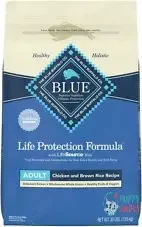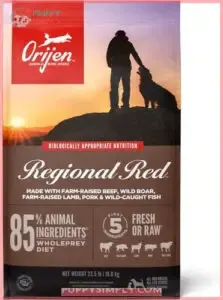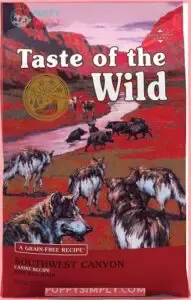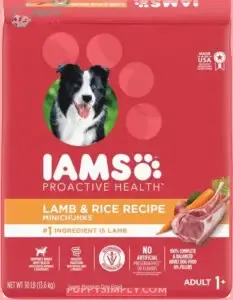This site is supported by our readers. We may earn a commission, at no cost to you, if you purchase through links.

Yes, Australian Shepherds are often considered picky eaters. This breed can be selective about their food preferences, with many owners reporting difficulty finding consistently enjoyable meals.
The causes can stem from health issues, behavioral factors, or genetic predisposition. Understanding your Aussie’s unique needs is key to addressing the problem.
Addressing underlying problems, offering a variety of high-quality options, and employing strategic feeding techniques can help you manage picky eating in your beloved companion. By delving deeper into the specifics of Australian Shepherd appetites, you’ll unravel the mystery to keeping your Aussie happy, healthy, and well-nourished.
Table Of Contents
- Key Takeaways
- Are Australian Shepherds Picky Eaters?
- Understanding Your Australian Shepherd’s Eating Habits
- How to Identify Picky Eating in Australian Shepherds
- Treatment for Picky Eating in Australian Shepherds
- Dietary Options for Picky Eating in Australian Shepherds
- Tips for Encouraging Eating in Australian Shepherds
- Top 8 Blue Merle Mini Aussie Dietary Options
- 1. Blue Buffalo Adult Chicken Brown Rice Dog Food
- 2. Orijen Regional Red Grain Free Dog Food
- 3. Southwest Canyon Grain-Free Dog Food
- 4. Purina Pro Plan Adult Large Breed Dog Food
- 5. Nutro Ultra Large Breed Adult Dog Food
- 6. Wellness Large Breed Puppy Chicken Rice Salmon
- 7. Iams Minichunks High Protein Lamb Dry Dog Food
- 8. Merrick Classic Beef Brown Rice Dog Food
- Preventative Measures and Nutritional Tips for Australian Shepherds
- Frequently Asked Questions (FAQs)
- What is the genetic predisposition to picky eating in Blue Merle Mini Aussies?
- How can I tell if my Australian Shepherd has a medical condition causing picky eating?
- What are the best ways to address behavioral issues related to picky eating?
- How can I encourage my picky eating Australian Shepherd to eat a variety of foods?
- What are the most effective dietary options for picky eating in Australian Shepherds?
- Conclusion
Key Takeaways
- Australian Shepherds are often considered picky eaters, with many owners reporting difficulty finding consistently enjoyable meals for their dogs.
- The causes of picky eating in Australian Shepherds can stem from health issues, behavioral factors, or genetic predisposition.
- To address picky eating in Australian Shepherds, owners should monitor their dog’s eating habits, offer a variety of high-quality food options, and employ strategic feeding techniques.
- Understanding an Australian Shepherd’s unique needs is crucial for addressing the problem and ensuring they stay happy, healthy, and well-nourished.
Are Australian Shepherds Picky Eaters?
No, Australian Shepherds are generally not picky eaters, but individual dogs may have their own unique preferences or eating habits. If an Aussie becomes selective with food, it’s important to weigh factors like health, diet changes, and behavior.
Understanding Your Australian Shepherd’s Eating Habits
As an Australian Shepherd owner, it’s important to understand your pup’s eating habits. Monitoring for sudden changes and consulting your veterinarian for persistent alterations can help identify underlying health issues or behavioral factors affecting your dog’s appetite.
Common Reasons for Loss of Appetite in Australian Shepherds
Stress and anxiety can lead to appetite loss in Australian Shepherds. If your picky eater is experiencing loose stool, consult a vet for prescription meds. Behavioral factors and dietary sensitivities may also contribute to appetite loss.
Health Issues Affecting Australian Shepherds’ Appetite
Underlying health issues such as pancreas, thyroid, or parasitic problems can have a substantial impact on your Australian Shepherd’s appetite, particularly in older dogs. Stress and anxiety can also be contributing factors.
Certain medical conditions can have a profound influence on your Aussie’s eating habits:
- Pancreas or thyroid disorders
- Gastrointestinal parasites
- Serious illnesses such as cancer or organ failure
- Dental problems causing pain or discomfort
If your adult or senior Aussie abruptly loses interest in food, consult your veterinarian to eliminate any underlying health issues that may be affecting their appetite. With appropriate treatment, you can help restore their enthusiasm for mealtime.
Behavioral Factors and Eating Habits
Behavioral factors play a significant role in your Australian Shepherd’s eating habits. They may exhibit boredom eating, stress eating, or anxiety eating. Attention-seeking, routine changes, and lack of exercise can also impact their appetite. To encourage eating, enhance meals with appetizing food toppers and make sure adequate hydration is provided. Establish a consistent feeding schedule and encourage appetite through exercise.
When to Seek Veterinary Care
When to Seek Veterinary Care for Your Australian Shepherd’s Appetite Changes
If your Australian Shepherd is experiencing a sudden or persistent change in appetite, it’s essential to consult a veterinarian. Here are three key reasons why:
- Rule out medical conditions: A veterinarian can perform a physical examination and run tests to determine if there’s an underlying medical condition causing the appetite change. This could include gastrointestinal disorders, food allergies, or nutritional deficiencies.
- Identify behavioral issues: A veterinarian can help assess if there are any behavioral factors contributing to the appetite change, such as stress, anxiety, or boredom.
- Address underlying causes: Depending on the diagnosis, your veterinarian may recommend treatments or dietary changes to address the root cause of the appetite change. This could include medications, dietary restrictions, or behavior modification techniques.
Preventative Measures and Nutritional Tips
To keep your Australian Shepherd healthy and happy, consider meal frequency, portion control, nutritional supplements, food allergies, diet rotation, and adjust feeding schedules based on life stages. Use food toppers for senior dogs and make certain of proper hydration.
How to Identify Picky Eating in Australian Shepherds
Is your Blue Merle Mini Aussie refusing to eat most foods and only prefers specific treats? This could be a sign of picky eating, a common issue in the breed often caused by genetic predisposition or behavioral factors like anxiety.
Symptoms of Picky Eating
Picky eating in Blue Merle Mini Aussies can manifest in several ways, and it’s important to identify these symptoms to address the issue effectively. Here are some common signs of picky eating in your Australian Shepherd:
- Refusal to eat most foods: If your dog consistently turns away from their food bowl, it could be a sign of picky eating.
- Preference for specific treats: If your dog has a preference for certain treats, such as turkey jerky or bully sticks, it could indicate a selective appetite.
- Weight loss or poor body condition: A sudden change in weight or a poor body condition can be a symptom of picky eating, as your dog may not be getting the necessary nutrients from their diet.
It’s vital to monitor these symptoms and consult a veterinarian if you suspect your dog is a picky eater, as there may be underlying medical conditions causing the behavior.
Causes of Picky Eating in Blue Merle Mini Aussies
Understanding the Causes of Picky Eating in Blue Merle Mini Aussies
Picky eating in Blue Merle Mini Aussies can have various causes, including genetic predisposition, medical conditions, and behavioral issues. Let’s explore these causes in detail:
- Genetic predisposition: Some dogs, including Blue Merle Mini Aussies, may have a genetic predisposition to being picky eaters. This means that their breed or lineage may make them more likely to be fussy about their food.
- Medical conditions: Medical issues such as allergies, digestive problems, and dental issues can lead to picky eating. For example, if a dog has an allergy to a specific ingredient in their food, they may refuse to eat it. Similarly, digestive problems like inflammatory bowel disease can cause discomfort and lead to a loss of appetite. Dental issues, such as toothaches or gum disease, can also make eating uncomfortable, causing a dog to be picky.
- Behavioral issues: Anxiety, boredom, and attention-seeking can also contribute to picky eating. Dogs may become picky if they’re anxious about their environment, bored with their regular food, or trying to get attention by refusing to eat.
To address picky eating in Blue Merle Mini Aussies, it’s imperative to rule out any underlying medical conditions. Consult a veterinarian if you suspect your dog has a medical issue causing their picky eating. Once medical conditions have been ruled out, focus on addressing behavioral issues and offering a variety of high-quality foods to encourage a balanced diet.
Treatment for Picky Eating in Australian Shepherds
If your Australian Shepherd is a picky eater, don’t worry – there are solutions. Start by ruling out any underlying medical conditions, then address any behavioral issues that may be contributing to the problem. Offering a variety of high-quality foods can help encourage your Aussie to eat.
Rule Out Medical Conditions
If your Blue Merle Mini Aussie is exhibiting picky eating behavior, it’s imperative to explore any underlying medical conditions that may be causing or contributing to their appetite loss. Some potential medical causes include pancreatitis, which can be triggered by a high-fat diet, idiopathic causes, or genetic predisposition in certain breeds like miniature schnauzers, cocker spaniels, dachshunds, and certain terrier and toy breeds. Other medical conditions that can affect appetite include ulcerative colitis, which can cause bloody diarrhea, weight loss, and increased frequency of defecation.
To exclude these conditions, your veterinarian may recommend blood tests to measure pancreatic enzymes, physical examination, and radiographs or ultrasound to visualize the pancreas and intestines. If your dog is diagnosed with pancreatitis, treatment may include a low-fat diet, fluids, and antibiotics for severe cases. For ulcerative colitis, treatment typically involves antibiotics to clear the E. Coli bacterial infection, with a positive response usually occurring within 2 weeks.
In addition to these specific medical conditions, it’s important to examine other factors that may affect your dog’s appetite, such as obesity, hormonal imbalances, elevated triglyceride or cholesterol levels in the blood, and other underlying conditions. By eliminating these medical conditions, you can focus on addressing any behavioral issues that may be contributing to your Blue Merle Mini Aussie’s picky eating.
Address Behavioral Issues
Addressing behavioral issues in your Blue Merle Mini Aussie’s picky eating can be achieved through several strategies.
First, consider environmental enrichment to reduce boredom and stress. This could include introducing new toys, puzzles, or activities that stimulate your dog’s mind and body.
Second, manage anxiety by creating a calm and consistent mealtime routine. This can involve feeding your dog in a quiet area away from distractions and ensuring they aren’t feeling anxious or stressed during mealtime.
Third, consider behavioral training to help your dog associate mealtime with positive experiences. This could involve rewarding your dog for eating their food or using positive reinforcement techniques to encourage them to eat.
Fourth, be aware of potential triggers that may cause your dog to become picky, such as changes in routine or new foods, and try to minimize these triggers when possible.
By addressing these behavioral issues, you can help your Blue Merle Mini Aussie develop ravenous appetites and enjoy their meals more.
Offer a Variety of High-quality Foods
Offering a variety of high-quality foods is essential for picky eaters like your Blue Merle Mini Aussie. High-quality options accommodate digestibility concerns, appealing flavors, and nutritional requirements. Consider brands like Orijen Regional Red and The Farmer’s Dog Fresh to address food sensitivities.
Dietary Options for Picky Eating in Australian Shepherds
If your Australian Shepherd is a picky eater, you can try offering boiled chicken and rice, wet dog food in various flavors, refrigerated dog food, or different types of dry dog food. Experiment with these dietary options to find which your Aussie enjoys and determine the best way to encourage them to eat.
Boiled Chicken and Rice
Boiled chicken and rice can be a beneficial dietary option for dogs experiencing gastrointestinal upset, loose stools, or a decreased appetite. This bland meal is easy to prepare and can help alleviate symptoms while providing necessary nutrition for recovery. To prepare boiled chicken and rice for your dog, follow these steps:
- Cook boneless, skinless chicken breasts until fully white inside and reach a temperature of 165°F (74°C).
- Boil white rice in a 1:2 ratio with water, cooking until the water is absorbed and the rice is tender.
- Shred the cooked chicken and mix it with the cooked rice in a 1:2 ratio.
- Offer the chicken and rice mixture every 2 hours, providing about ⅓ of your dog’s usual food amount.
Remember to consult with your veterinarian before making any dietary changes, as a bland diet should only be used for a short period and may not be suitable for dogs with certain health conditions or allergies. Additionally, be sure to store any leftovers in an airtight container in the fridge for up to 3-4 days or in the freezer for up to 2-6 months.
Wet Dog Food (various Brands and Flavors)
Wet dog food is a popular choice for picky eaters due to its variety of flavors and textures. Different brands offer a range of options, including chicken, beef, and fish. When selecting wet dog food for your Blue Merle Mini Aussie, consider the ingredients, nutritional content, and your dog’s preferences. Some brands even offer grain-free or limited ingredient options, which can be beneficial for dogs with sensitive stomachs.
To make mealtime more enjoyable for your picky eater, consider mixing wet and dry dog food. This combination can provide a balanced and nutritious diet while offering a variety of textures and flavors that your dog may find more appealing. Additionally, wet food can be warmed up to enhance its aroma and palatability.
Remember to monitor your dog’s weight and adjust their diet accordingly, as wet food tends to be lower in calories compared to dry food. If your dog isn’t finishing their meals, try switching up the shapes, textures, and aromas to encourage them to eat.
Refrigerated Dog Food
Refrigerated dog food strikes a balance between freshness and convenience. Here are four crucial aspects to contemplate:
- Shelf life: Refrigerated dog food possesses a briefer shelf life in comparison to dry or wet dog food, typically lasting 7-10 days.
- Spoilage prevention: To avert spoilage, refrigerate the food promptly upon opening and consume within the prescribed time frame.
- Freshness preservation: The refrigeration process assists in preserving the food’s freshness and flavor, rendering it more inviting to your discerning eater.
- Flavor: The freshness of refrigerated dog food can intensify the flavor, making it more alluring to your Australian Shepherd.
Dry Dog Food (different Types)
Selecting the appropriate dry dog food for your Australian Shepherd can be a daunting task, as they’ve specific nutritional requirements due to their high energy levels. However, with the requisite knowledge and options, you can guarantee that your furry companion receives the optimal nutrition.
When choosing dry dog food for your Australian Shepherd, consider the following factors:
- High-quality protein: Look for dog food that lists real meat, such as chicken, beef, or fish, as the primary ingredient. Adequate protein intake supports their active lifestyle and aids in muscle repair and growth.
- Essential fats: Fats, particularly Omega-3 and Omega-6 fatty acids, play a significant role in an Australian Shepherd’s diet. They provide energy, support brain function, and help maintain a healthy coat and skin.
- Carbohydrates: Opt for complex carbohydrates like sweet potatoes, brown rice, and oats, which offer long-lasting energy and aid in maintaining a healthy digestive system. Avoid excessive simple carbohydrates to prevent weight gain.
- Vitamins and minerals: A range of vitamins and minerals is essential for the overall health of Australian Shepherds. Look for foods fortified with essential vitamins like A, D, E, and B-complex, and minerals like calcium and phosphorus. These nutrients support immune health, bone strength, and various bodily functions.
- Portion control: Manage your dog’s weight by feeding them the recommended amount of food based on their age, size, and activity level.
Now, let’s explore some top dry dog food options for your Australian Shepherd:
- IAMS Adult Minichunks Small Kibble High Protein Dry Dog Food with Real Chicken: This option is suitable for smaller bites and contains high-quality protein to support muscle development and repair.
- Blue Buffalo Life Protection Formula Natural Adult Healthy Weight Dry Dog Food, Chicken and Brown Rice: This food is formulated for healthy weight management and contains real chicken as the primary ingredient.
- Hill’s Science Diet Dry Dog Food, Adult, Sensitive Stomach & Skin, Chicken Recipe, 30 lb. Bag: This dog food is designed for sensitive stomachs and promotes digestive health while nourishing skin.
- VICTOR Super Premium Dog Food – Hi-Pro Plus Dry Dog Food: Known for its high-quality ingredients and exclusive mix of supplements, vitamins, and minerals, this dog food is a great option for active dogs like Australian Shepherds.
- The Honest Kitchen’s Grain Free Beef Clusters: This grain-free option provides a balanced nutritional profile with the necessary levels of fat and protein for a high energy dog.
Tips for Encouraging Eating in Australian Shepherds
Australian Shepherds can be picky eaters, but you can encourage them to eat by leaving food out for extended periods and mixing their preferred treats with new foods. Warming up wet food and adding appetizing toppers like gravy or pumpkin may also tempt your Aussie’s palate, but you’ll want to avoid giving in to picky behavior.
Leave Food Out for Extended Periods
After exploring dietary options, consider food availability; leaving meals out may encourage nibbling. Discuss portion control and meal frequency with your vet.
Mix Preferred Treats With New Foods
Mixing preferred treats with new foods can be a rewarding way to encourage your Australian Shepherd to try new dietary options. Here are some tips:
- Reward-based training: Use treats as positive reinforcement during training sessions.
- Dietary supplements: Add nutritional supplements to meals for a balanced diet.
- Nutritional counseling: Consult a vet for personalized dietary advice.
- Home-cooked meals: Prepare meals at home with ingredients approved by your vet.
Warm Up Wet Food
Warming up wet food can be a helpful strategy to encourage your Australian Shepherd to eat. Here are some tips and ideas:
- Wet Food Temperature: Warm the food slightly before feeding it to your dog. This can make the food more appealing and easier to digest. However, be careful not to overheat the food, as it can cause discomfort or even burns to your dog’s mouth.
- Wet Food Additives: If your dog is sensitive to cold foods or simply doesn’t like them, you can mix a little warm water into their wet food before feeding it to them. This can help make the food more palatable and easier to eat.
- Wet Food Brands: Choose a high-quality wet food brand that your dog enjoys. Some dogs prefer chunky bites, while others love flakes. There are now a wide variety of wet or canned food products that come in various texture options, such as chunky, flaked, minced, sliced, pate, and puree.
- Wet Food Storage: Store opened cans of wet food in an airtight container in the refrigerator for up to 5 days. If your dog is sensitive to cold foods, you can warm the food slightly before feeding it to them.
Add Toppers (gravy, Pumpkin)
Adding pumpkin varieties or gravy flavors to your Australian Shepherd’s meal can be a game-changer. Cater to their texture preferences and nutritional needs. Pumpkin, for instance, has digestive benefits, while gravy can make meals more appealing.
Avoid Giving in to Picky Behavior
Resist caving to food refusal; it’s a slippery slope. Instead, balance nutritional composition, tweak the feeding routine, manage stress, and smartly use treats.
Top 8 Blue Merle Mini Aussie Dietary Options
Are your Blue Merle Mini Aussie’s eating habits leaving you concerned? Consider these 8 high-quality dog food options that may entice your picky pup’s appetite – from nutrient-rich formulas like Blue Buffalo and Orijen to savory flavors like Southwest Canyon and Merrick Classic Beef.
1. Blue Buffalo Adult Chicken Brown Rice Dog Food
Blue Buffalo Adult Chicken Brown Rice Dog Food is a high-quality, protein-rich dry dog food that can be an appropriate choice for your Blue Merle Mini Aussie. This food comprises deboned chicken as the primary ingredient, whole grains, garden veggies, and fruits, alongside LifeSource Bits, which furnish antioxidants, vitamins, and minerals. It’s absent of corn, wheat, and soy, making it a grain-free alternative for dogs with sensitivities to these components.
The food has a crude protein content of 24% and a crude fat content of 14%, which are within the suggested ranges for an average dog’s diet. It also incorporates L-Carnitine, Turmeric, Vitamin C, Taurine, and Probiotics, which can aid your dog’s overall well-being. The food is available in varying sizes to accommodate diverse breeds and life stages.
To acclimate your dog to this food, it’s advised to gradually introduce it over a span of several days, intermingling it with their prevailing food and incrementally augmenting the proportion of Blue Buffalo. This will assist your dog in adapting to the novel food and mitigate the likelihood of gastrointestinal distress.
Best For: Blue Merle Mini Aussies and other dogs that thrive on a grain-free diet with real chicken as the primary ingredient.
- High in protein for muscle development
- Contains antioxidants, vitamins, and minerals
- No corn, wheat, or soy
- May be more expensive than other dog food options
- Some dogs may be allergic to chicken
- Packaging may vary
2. Orijen Regional Red Grain Free Dog Food
If your Blue Merle Mini Aussie is a picky eater, you might want to consider trying Orijen Regional Red Grain Free Dog Food. This top-notch, grain-free option is brimming with 85% animal protein and whole prey inclusions, ensuring your dog receives the nutrients they require for immune, skin, coat, and digestive health.
Plus, it’s devoid of soy, corn, tapioca, and wheat, making it an ideal choice for dogs with delicate stomachs. And with a freeze-dried coating for enhanced flavor, even the fussiest eaters might be enticed to give it a shot.
Best For: Picky eaters, dogs with delicate stomachs, and those on a raw diet.
- 85% animal protein and whole prey inclusions for optimal nutrition
- Grain-free, chicken-free, and free from soy, corn, tapioca, and wheat
- Freeze-dried coating enhances flavor and entices picky eaters
- Not suitable for growing large breed dogs
- May cause digestive issues if not transitioned gradually
- Higher cost than some other dog food options
3. Southwest Canyon Grain-Free Dog Food
Southwest Canyon Grain-Free Dog Food is another excellent option for your Blue Merle Mini Aussie. This dog food is crafted with real meat as the #1 ingredient, ensuring your furry friend gets the protein they need. With 29% protein content, it’s a high-protein diet that also includes vitamins and minerals from real fruits and superfoods.
Omega fatty acids support skin and coat health, while species-specific K9 Strain Proprietary Probiotics and antioxidants promote healthy digestion and immune system health.
Made in the USA with quality ingredients, this grain-free dog food is a great choice for your Australian Shepherd.
Best For: Adult dogs of all breeds, including Blue Merle Mini Aussies.
- High-protein content (29%)
- Crafted with real meat and fruits/superfoods
- Supports skin and coat health, digestion, and immune system health
- May not be completely grain-free
- Some dogs may not like the taste
- Not specified if suitable for all life stages or just adults
4. Purina Pro Plan Adult Large Breed Dog Food
Purina Pro Plan Adult Large Breed Chicken & Rice Formula Dry Dog Food is a high-quality, complete and balanced diet designed for large breed dogs weighing 50 pounds or more. It features real chicken as the first ingredient and contains 26% protein and 12% fat to help maintain your dog’s ideal body condition.
This highly digestible formula promotes efficient nutrient absorption and supports joint health and mobility with glucosamine and EPA, an omega-3 fatty acid. The recipe also contains natural prebiotic fiber sourced from wheat bran, which helps promote digestive well-being.
Every serving of this dog food for large breeds contains omega-6 fatty acids and vitamin A to nourish skin and coat, ensuring your dog looks his best. The high level of protein, combined with proper exercise, helps promote muscle development.
Best For: Large breed dogs weighing 50 pounds or more.
- Contains 26% protein and 12% fat to help maintain your dog’s ideal body condition.
- Promotes joint health and mobility with glucosamine and EPA, an omega-3 fatty acid.
- Contains omega-6 fatty acids and vitamin A to nourish skin and coat.
- Contains corn gluten meal, which can be difficult for some dogs to digest.
- Does not contain any fruits or vegetables.
- May be too high in protein for some dogs.
5. Nutro Ultra Large Breed Adult Dog Food
Nutro Ultra Large Breed Adult Dog Food is a high-quality, nutritious option for your Blue Merle Mini Aussie. This dry dog food is formulated with real chicken as the first ingredient and contains essential nutrients such as glucosamine, omega-3 and -6 fatty acids, and taurine.
It also includes a variety of fruits and vegetables for added flavor and gourmet nutrition.
However, some users have reported mixed experiences with this food, with some dogs experiencing diarrhea and vomiting after switching to it. It’s essential to monitor your dog’s reaction to the food and consult with your veterinarian if you notice any adverse effects.
Best For: Large-breed dogs, such as the Blue Merle Mini Aussie.
- Made with high-quality ingredients and contains 14 superfoods for abundant flavor and gourmet nutrition
- Formulated with real chicken as the number one ingredient and provides essential nutrients like glucosamine, omega-3 and -6 fatty acids
- Includes natural sources of glucosamine and chondroitin
- Price has increased significantly
- Delivery service (FedEx) has been unreliable
- Manufacturer has downsized package for the same price
6. Wellness Large Breed Puppy Chicken Rice Salmon
Regarding feeding your Blue Merle Mini Aussie, the Wellness Large Breed Puppy Chicken Rice Salmon is akin to winning the lottery. This delicacy is meticulously crafted in the United States, employing only the most exquisite ingredients that exude excellence with each morsel.
It resembles a lavish banquet for your canine companion, replete with premium-grade proteins and wholesome grains that guarantee your furry friend’s tail remains in perpetual motion. Moreover, the inclusion of DHA and omega fatty acids serves as the secret formula for intelligent pups and lustrous coats.
This isn’t mere sustenance; it’s an investment in a healthy, vibrant existence for your growing Aussie. Therefore, let’s abandon the dinnertime chaos and present a bowl of this culinary masterpiece. Your pup’s palate (and overall well-being) will express its gratitude!
Best For: Large breed puppies that require a nutritious diet to support their growth and development.
- Formulated with premium proteins and wholesome grains for optimal nutrient absorption and healthy muscle growth
- Contains omega fatty acids, essential vitamins, antioxidants, glucosamine, and probiotics for whole-body nutritional support
- Encourages teeth and bone strength, supports healthy brain development, and promotes overall health, energy, and vitality
- Some customers have reported that their puppies have experienced diarrhea while eating this food
- The kibble size may be too large for some puppies
- The food may not be palatable to all puppies
7. Iams Minichunks High Protein Lamb Dry Dog Food
When evaluating dietary choices for your Blue Merle Mini Aussie, Iams Minichunks High Protein Lamb Dry Dog Food is a well-liked pick. This food is formulated with genuine lamb as the primary ingredient, presenting a premium protein supply that promotes healthy digestion with a combination of fibers and prebiotics. The omega-6 fatty acids in the food foster a healthy skin and coat, while the personalized blend of natural fiber and prebiotics promotes healthy digestion.
Iams Minichunks High Protein Lamb Dry Dog Food is accessible in different sizes, including a 15-lb bag, which is appropriate for numerous households. The food is also enhanced with antioxidants to bolster a strong immune system and carries 7 essential nutrients to support heart health.
When altering your dog’s food to this one, it’s significant to adhere to the recommended transition plan to prevent digestive problems. Over 4 days, gradually lessen the quantity of your dog’s present food while escalating the amount of Iams Minichunks High Protein Lamb Dry Dog Food.
Best For: Blue Merle Mini Aussies and dog owners seeking high-protein, premium lamb-based dry dog food with digestive support.
- Formulated with genuine lamb as the primary ingredient for a premium protein source
- Contains a tailored blend of natural fiber and prebiotics to support healthy digestion
- Enriched with antioxidants to support a strong immune system
- May not be suitable for dogs with chicken allergies
- Smaller kibble size may not be optimal for all dogs
- Availability of different sizes may vary
8. Merrick Classic Beef Brown Rice Dog Food
Merrick Classic Beef Brown Rice Dog Food is a well-liked choice among pet owners, offering a well-rounded mix of protein, fruits, vegetables, and whole grains, including ancient grains like quinoa, to support healthy digestion in your Blue Merle Mini Aussie. This recipe is abundant in fiber, Omega-3 and -6 fatty acids, glucosamine, and chondroitin, making it a great choice for maintaining your dog’s overall health.
Key ingredients in Merrick Classic Beef Brown Rice Dog Food include deboned beef, pork meal, brown rice, barley, oatmeal, and a variety of fruits and vegetables, such as carrots and apples. The food is free from potatoes, peas, lentils, artificial colors, flavors, and preservatives, ensuring a natural and wholesome meal for your dog.
To encourage your Blue Merle Mini Aussie to eat, consider the following tips:
- Mix preferred treats with new foods: Introduce new foods gradually by mixing them with your dog’s favorite treats, such as turkey jerky or bully sticks.
- Warm up wet food: Warming up wet food can make it more appealing to your dog.
- Add toppers: Adding gravy or pumpkin toppers can enhance the flavor and palatability of the food.
- Avoid giving in to picky behavior: Stick to a consistent feeding schedule and avoid giving in to your dog’s picky eating habits.
If your Blue Merle Mini Aussie continues to show signs of picky eating or loss of appetite, consult with your veterinarian to rule out any underlying medical conditions.
Best For: Adult dogs of all breeds and sizes, especially those with sensitive digestion or joint issues.
- High-protein recipe with real deboned beef as the first ingredient
- Holistic blend of whole grains and ancient grains for healthy digestion
- Joint support with glucosamine and chondroitin
- Some recent bags reported to have crumbly kibble, different smell, and gastrointestinal issues in dogs
- Expensive compared to other brands
- May not be suitable for dogs with allergies or sensitivities to certain ingredients
Preventative Measures and Nutritional Tips for Australian Shepherds
Australian Shepherds are prone to picky eating, but you can encourage their appetite by enhancing meals with appetizing toppers and ensuring they stay hydrated. Establishing a consistent feeding schedule and incorporating exercise into their routine can also help stimulate their desire to eat.
Enhance Meals With Appetizing Food Toppers
Enhance your Aussie’s meals with food additives, flavor enhancers, palatable toppings, tempting treats, and enticing aromas to boost their appetite.
Ensure Adequate Hydration (moistening Dry Food)
Make sure your Australian Shepherd stays hydrated by moistening dry food with water or low-sodium broth. This supports digestion, maintains electrolyte balance, and promotes urinary tract health. Regularly monitor water intake to prevent dehydration.
Switch Dog Food Brands Thoughtfully
Changing dog food brands? Do it carefully. A gradual changeover is important to avoid stomach problems and reintroduce old food easily.
- Start with a small mix of new and old food.
- Gradually increase the new food portion over a week.
- Watch your Aussie’s reaction to the change.
- Keep hydration in check during the changeover.
- Reintroduce old food occasionally to maintain dietary variety.
Establish a Consistent Feeding Schedule
Establishing a consistent feeding schedule is essential for your Australian Shepherd’s well-being. Aim for feeding frequency, meal timing, portioning, bowl placement, and water availability.
Encourage Appetite Through Exercise
- Exercise snacks: Short bursts of activity throughout the day.
- Exercise routine: A consistent schedule for walks and playtime.
- Exercise options: Variety keeps your dog engaged and stimulated.
Frequently Asked Questions (FAQs)
What is the genetic predisposition to picky eating in Blue Merle Mini Aussies?
Like a genetic ticking time bomb, Blue Merle Mini Aussies may be predisposed to picky eating, leaving you scratching your head, wondering Why won’t my pup chow down? Fear not – there are solutions!
How can I tell if my Australian Shepherd has a medical condition causing picky eating?
If your Aussie won’t eat, it’s wise to consult your vet. They can rule out underlying medical issues like food allergies or GI problems that may be causing the picky behavior. Time to get to the root of the issue!
What are the best ways to address behavioral issues related to picky eating?
Stimulate your Aussie’s mind with enriching activities like treat puzzles and scavenger hunts to curb picky eating. Alleviating boredom and anxiety can work wonders in getting them to enthusiastically dig into their meals.
How can I encourage my picky eating Australian Shepherd to eat a variety of foods?
To coax your picky Aussie‘s appetite, rotate high-quality proteins and textures, add tasty toppers, and make mealtimes engaging. With patience and creativity, you can broaden their palate and have them chowing down in no time.
What are the most effective dietary options for picky eating in Australian Shepherds?
Try tempting your Aussie with wet, refrigerated, or home-cooked meals like boiled chicken and rice. Add tasty toppers like gravy or pumpkin to dry food to entice their appetite. Keep exploring until you find their favorite flavors!
Conclusion
Without a doubt, Australian Shepherds can be the most finicky eaters you’ll ever encounter. Addressing any underlying health issues, offering a variety of high-quality food options, and employing strategic feeding techniques are key to managing the picky eating habits in Australian Shepherds.
By understanding your Aussie’s unique dietary needs, you can overcome their picky eating habits and guarantee they stay happy, healthy, and well-nourished. With patience and the right approach, you’ll have your Aussie happily consuming their meals in no time.



















